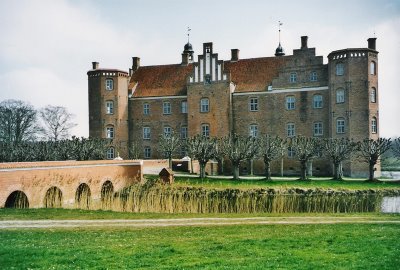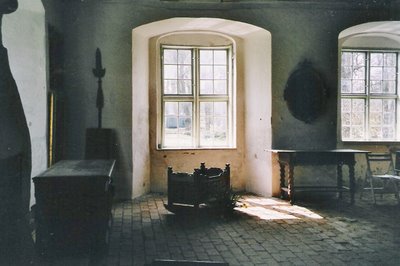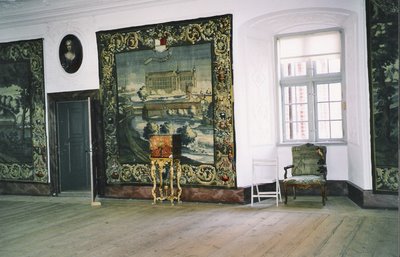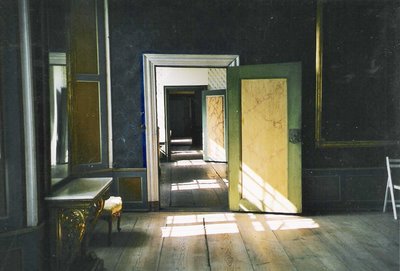
Gammel Estrup, 19 km east of Randers

Gammel Estrup is built in a specific style signifying Gothic Renaissance. For how long this estate was a manor is not known, but as soon as 1340 it had a certain significance in an agreement between hertug Valdemar III of Sønderjylland an grev Gert's sons, Henrik and Claus. Anders Jensen had his farm in Estrup returned and was signed to it in 1341. His widow Johanne Brok (+1372), belonged to a rich and powerful family, who already in Erik Menved's reign had achieved the family name Brok ( the name means badger) . She joined the Jute magnates, who after Niels Bugge's murder rebelled against Valdemar Atterdag, and he in return attacked and conquered the private castles on Djursland in 1359, among those Estrup.

A nice little cradle in a simple room.

The interior is marked by the taste of the 1700s.
Johanne Brok's son hr. Jens Andersen Brok of Essendrup(Estrup) is mentioned as a ridder (knight) in 1358. He was a supporter of Valdemar Atterdag and fought for him in 1368-70, while he was a vassal at Bygholm Castle (by Horsens). In Valdemar Atterdag's last years he had the high office as drost and continued later as one of queen Margrethe I's leading advisers. In 1386 king Oluf visited him at Essendrup and issued a letter that hr. Jens of Æsenthorp had bought estate in Kristrup (at Randers) from hr. Peder Albertsen Eversten (= Eberstein).

Some of the Flemish tapestry in the banqueting hall, showing the different manors in Jørgen Skeel's ownership.

A look through some rooms with solid floor planks and some of the old painted doors.
His grandson Esge Jensen Brok (+1441) inherited Estrup, which came to his son hr. Lave Brok, who was known for his violent nature. He built his late Gothic water castle ab. 1441, which in about 1590 was rebuilt to its present state by Esge Brok upon the foundations of Lave Broks castle. Esge Brok was the last male in the family-line, and when his daughter Jytte Brok married Jørgen Skeel of Sostrup, Estrup came in 1625 into the ownership of the Skeel/Scheel-family and was in this family for the next 300 years.
Gammel Estrup's red walls in three storeys are placed upon a narrow castle bank surrounded by water moats on all sides. The earliest brickwork is seen in the present gatehouse in the west wing, which two bottom stories holds the rest of Lave Brok's stone house from the end of the 1400s.

The old porcelain was also regained
After Christian Skeel's death in 1926 his heirs auctioned off the house and all contents, but in 1930 Jyllands Herregårdsmuseum was established, and during the years considerable parts of the contents have been regained. Since the 1950's the well-preserved interior was thouroughly restored. The big farmbuilding complex, where the stables and waggon department origin from the 1600s, is now a part of Dansk Landbrugsmuseum.
Gammel Estrup's old park in spring.



Gammel Estrup's old garden is situated on the north side of the moat . The park contains rests of the original Baroque garden and two small orangeries from 1722. In the lawns are historical roses.
Jyllands Herregårdsmuseum in main building. Landbrugsmuseum in farm building complex.
Park with orangery. Restaurant and café. Boutique. Open all year.
photo: grethe bachmann
No comments:
Post a Comment